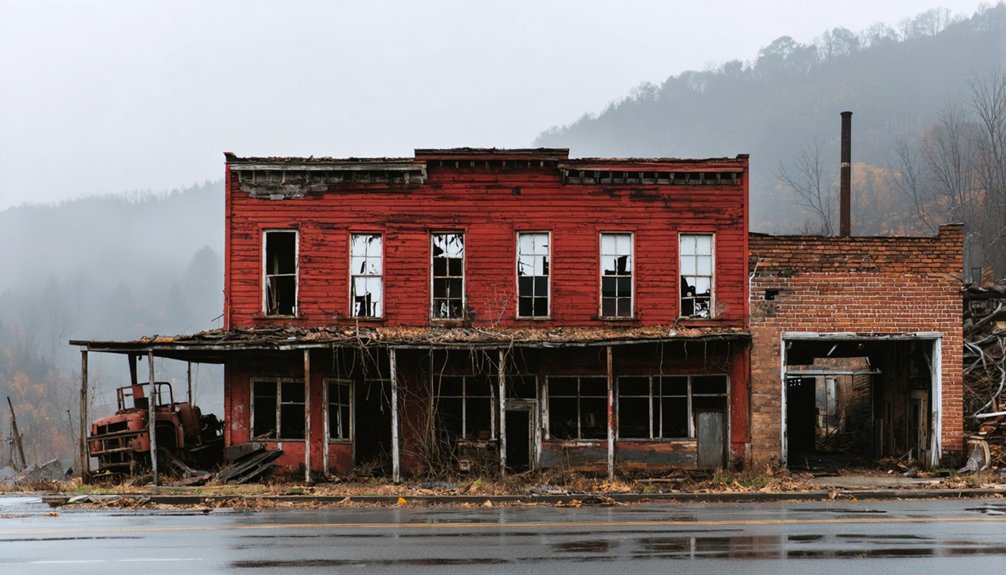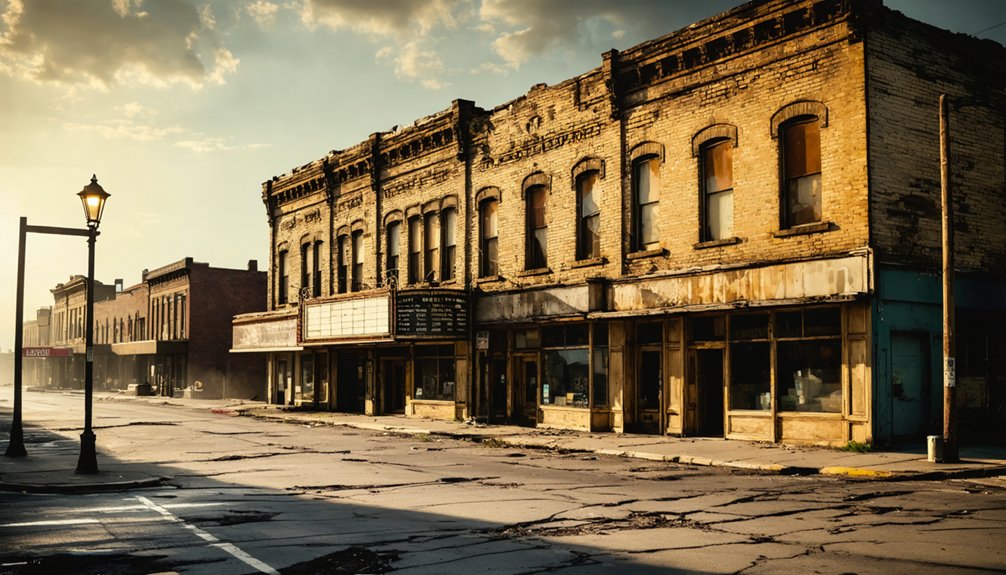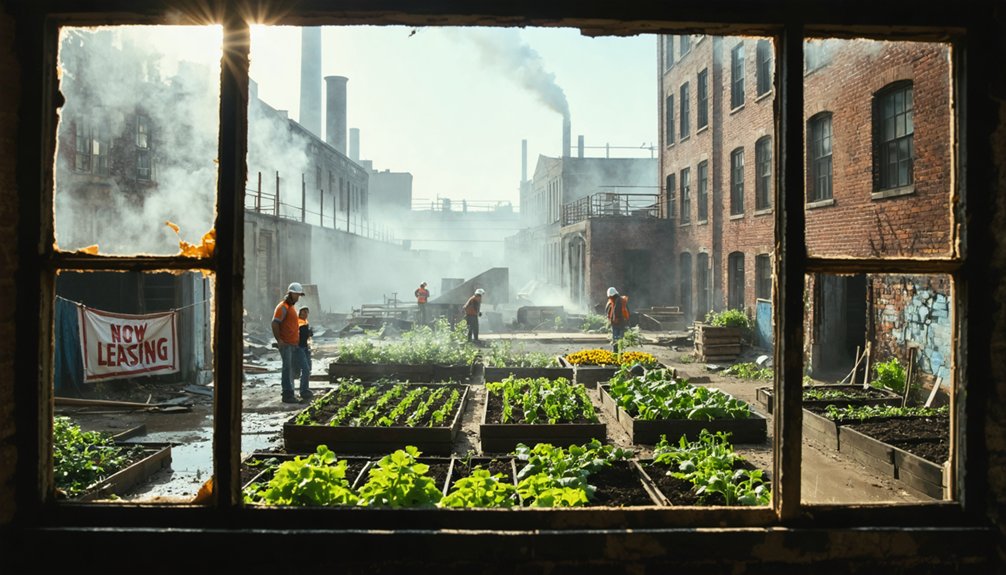Abandoned coal mining towns across Appalachia and the Rust Belt offer windows into America’s industrial past. You’ll find Victorian manager homes contrasting with worker housing, all slowly reclaimed by nature. Once-bustling communities like McDowell County—formerly the “Coal Capital of the World”—now stand as architectural timelines of boom and bust cycles. Churches and schools often remain as the most intact structures amid the decay. The story beneath these ruins reveals America’s complex industrial heritage.
Key Takeaways
- Abandoned coal towns showcase Victorian architecture alongside utilitarian worker housing, creating a physical timeline of industrial rise and fall.
- Over 2.5 million acres across the Rust Belt contain partially reclaimed or abandoned mining sites worth exploring.
- Photographers document these ghost towns through images of rusted mine entrances, collapsed storefronts, and weathered historic signage.
- Many former mining sites have been transformed into museums, parks, or historical landmarks preserving the region’s industrial heritage.
- Visitors should prepare for structural instabilities while respecting both the privacy of remaining residents and environmental sensitivities.
The Rise and Fall of America’s Coal Mining Heartland

As the 19th century unfolded across America’s future industrial heartland, coal mining emerged as the cornerstone of what would eventually become the Rust Belt’s economic identity.
You can trace this economic transformation to 1816, when coke first fueled iron production in Pennsylvania’s Fayette County.
The perfect storm of natural resources—abundant coal reserves, iron ore, and waterways—created unprecedented industrial growth.
Nature’s industrial trifecta—coal, iron, and water—unleashed an economic revolution across America’s heartland.
Steel corporations flourished as coal-powered blast furnaces replaced charcoal operations by 1875.
European immigrants poured into mining towns, where labor movements gained momentum through strikes like those in 1870s Fayette County.
Transportation networks expanded significantly when the Huntingdon and Broad Top Railroad was completed in 1853, enabling efficient coal shipment throughout the region.
By the 1970s, these once-thriving mining communities began experiencing significant decline as foreign competition and technological advancements dramatically reduced coal industry employment.
Ghost Towns of Appalachia: Where Time Stands Still
The bustling coal towns that once dotted Appalachia’s valleys and ridgelines now stand frozen in time—empty storefronts, abandoned company houses, and silent mine entrances marking what locals call “ghost towns.”
These forgotten communities represent the stark aftermath of coal’s decline, where environmental devastation meets economic collapse.
You’ll find over 2.5 million acres of affected land, with more than 426,000 acres partially reclaimed or completely abandoned.
“Zombie mines” continue poisoning watersheds while populations flee—prime-age residents departing at unprecedented rates.
Local ghost stories often intertwine with the visible scars of mountaintop removal that’s eliminated 500 peaks.
Despite this devastation, community resilience persists.
In places like Norton, Virginia, where coal production plummeted from hundreds of thousands of tons to nearly zero, residents struggle against elevated disease rates and economic uncertainty while seeking alternative futures. Interactive maps now visualize these dramatic production changes with black arrows indicating towns that have reached zero production by 2024.
The Surface Mining Control and Reclamation Act of 1977 created a critical distinction between abandoned mine lands and modern-era mines that affects how cleanup responsibilities are assigned.
Exploring McDowell County: The Forgotten Coal Capital

Once known as the “Coal Capital of the World,” McDowell County epitomizes both the meteoric rise and devastating collapse of America’s coal industry.
When you visit today, you’ll find haunting remnants of a region that exploded from agrarian roots to industrial powerhouse after railroad completion in 1883.
As you explore, you’ll witness physical testimony to labor struggles that defined this landscape—company stores where miners faced economic bondage and the courthouse that oversaw contentious union battles. Many miners were forced into oppressive yellow-dog contracts that prohibited them from joining unions.
Coal production skyrocketed from 246,000 tons in 1889 to 12 million by 1910, before mechanization and market forces devastated communities.
The county’s cultural heritage remains embedded in abandoned infrastructure and declining towns.
Where 100,000 people once lived during the 1950s peak, you’ll now find a shrinking population still grappling with coal’s complex legacy. By the 1980s, the region suffered catastrophic economic decline with over 70,000 coal mining jobs lost across the area.
Architectural Remnants: From Luxury to Abandonment
Walking through abandoned coal towns today, you’ll witness a striking architectural timeline that chronicles the boom-to-bust trajectory of America’s industrial heartland.
Victorian details on managers’ homes contrast sharply with utilitarian worker housing—all now surrendering to urban decay.
You’re looking at the physical embodiment of industrial collapse: once-proud brick buildings with distinctive Gothic windows stand partially reclaimed by nature.
Churches and schools, built with community pride, often remain the most intact structures amid the deterioration.
Efforts in architectural conservation have saved some buildings through adaptive reuse.
Former company stores become museums, while industrial sites transform into parks or art spaces—preserving the authentic materials and details that tell the Rust Belt’s story.
Each crumbling facade and boarded window represents both forgotten prosperity and potential rebirth.
The transformation of these abandoned sites mirrors the German Ruhr Valley approach, where slag heaps created artificial landscapes that now offer unique views of the surrounding industrial heritage.
Communities like McKeesport and Braddock show the lasting impact of industrial decline with their unoccupied buildings and population loss reflecting the harsh economic realities of post-steel America.
Photographing History: Capturing the Decay of Former Boomtowns

Photographers trek to abandoned coal towns armed with cameras and tripods, seeking to preserve what time steadily erases. When practicing urban exploration, you’ll encounter common subjects that tell powerful stories—rusted mine entrances, collapsed storefronts, and weathered signage that chronicle industrial collapse.
Technical challenges abound. You’ll need high ISO settings for dim interiors, protective gear for your equipment against omnipresent dust, and awareness of structural instabilities that threaten both photographer and subject. From sites like Kaymoor One Mine, now part of New River Gorge National Park, you’ll witness nature’s resilience as forest regrowth gradually reclaims industrial ruins. Towns like Centralia in Pennsylvania offer stark visuals with its ongoing underground coal fire that has forced almost complete abandonment.
Your photography serves dual purposes: documenting decay while preserving history. Mastering photographic techniques isn’t merely about capturing compelling images—it’s about ethical storytelling.
Avoid trespassing, respect former residents’ privacy, and provide context for your work. Through your lens, you’re not just recording ruins but archiving cultural memory for future generations.
Frequently Asked Questions
Are Abandoned Coal Towns Safe for Tourists to Explore?
No, they’re not safe. You’ll face deadly hazards including hidden mine shafts, toxic gases, and contaminated water. Follow tourist guidelines and legal requirements to mitigate these serious safety concerns.
What Permits Are Required for Visiting Restricted Mining Sites?
You’ll need federal permits from BLM or Forest Service, plus state-specific authorizations. The permits process involves detailed applications with liability insurance. Legal implications include fines for unauthorized access to restricted mining areas.
How Can Visitors Connect With Local Historians During Tours?
You’ll find local historians through heritage tourism organizations’ guided programs, academic field studies, and community gathering events featuring historical storytelling and local folklore that provide meticulous documentation and contextual interpretation of mining communities.
What Survival Equipment Should Explorers Bring to Abandoned Towns?
You’ll need survival gear including water purification systems, ferrocium rods, headlamps, fixed-blade knives, and emergency sleeping bags. Exploration safety demands helmets, first aid kits, and multiple lighting sources for subterranean investigations.
Do Former Residents Hold Reunions or Heritage Events?
Like scattered pixels reforming, you’ll find reunion traditions persist as small, community gatherings—typically heritage-focused events organized by descendants, historical societies, and museums rather than large-scale annual affairs. These memory-preserving occasions remain geographically dispersed.
References
- https://www.youtube.com/watch?v=YL99C9VfThs
- https://www.youtube.com/watch?v=hHyXN5QmQHk
- https://www.loveexploring.com/gallerylist/127789/then-and-now-us-rust-belt-cities-that-bounced-back
- https://allthatsinteresting.com/rust-belt
- https://hillbillyhighways.wordpress.com/2019/07/17/life-in-the-mountains-after-coal/
- https://www.britannica.com/place/Rust-Belt
- https://en.wikipedia.org/wiki/Rust_Belt
- https://www.iup.edu/library/departments/archives/coal/coal-culture-timeline.html
- https://blog.midwestind.com/wp-content/uploads/2017/11/coal_timeline.pdf
- https://pressbooks.ulib.csuohio.edu/community-development-cleveland-eh/chapter/chapter-1/



